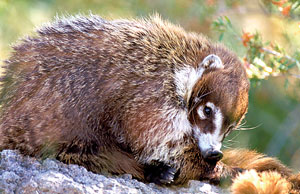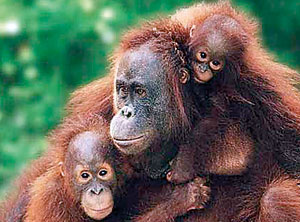| Cloud forests are evergreen
mountain forests that are almost permanently shrouded in mist and clouds. Cloud forests are a rare
habitat of tropical mountains filled with exceptional concentrations of biodiversity and sources of fresh water according to the Cloud Forest Agenda. And, says the report, they have not received sufficient attention for these gifts.
Although they make up no more than 2.5 percent of the world’s
tropical forests they harbor a
disproportionately large number of the world’s species. The wealth of
biodiversity includes the wild
relatives and sources of genetic
diversity of many of our staple crops, like beans, potatoes and coffee, explains the Cloud Forest Agenda.
 |
| A white-nosed coati or coatimundi,
Nasua narica. These gregarious beasts can roam for hundreds of miles foraging for insects, berries and fruits.
© Francis Apesteguy/Sardine Features. |
The Cloud Forest Agenda, (Bubb, May et al.), is a report of the Mountain Cloud Forest Initiative, which is a partnership between the United Nations Environment Program (UNEP) and its World Conservation Monitoring Centre (WCMC), the United Nations Educational, Scientific and Cultural Organization (UNESCO) and its Man and the Biosphere (MAB) Program and International Hydrological Program (IHP), and IUCN –
The World Conservation Union and its Commission on Ecosystem Management.
Hummingbirds, spectacled bears and mountain tapirs are among the curious creatures that dwell in cloud forests. This animal kingdom in the clouds is also one of the preferred habitats of the coati in its Central and South American range.
The coati is a gregarious beast bearing an elfish resemblance to
raccoons and opossums. They are inveterate wanderers, inhabiting a host of wooded areas – dry forests, rain forests, cloud forests – as well as deserts and canyons of the Americas.
It is an unusual though attractive looking beast – a sort of skinny
shovel-nosed raccoon with a long ringed tail. Coatis wander from
habitat to habitat depending upon the seasons either as a lone male or a band of up to 50 females with their young, explains the Arizona-Sonora Desert Museum, a world-renowned natural history museum and
conservation center. Handy with their front paws they will even turn over stones to see if there is a tasty snake or lizard lurking beneath.
Coatis are members of the
procyonids family, a rather
handsomely marked group that includes the raccoon and the ringtail. Crushing molars, sharp incisors and large canine teeth enable the coati to enjoy its omnivorous diet of plant foods, insects, small reptiles and the
occasional tiny mammal.
Orang-utans
Animal Families
A baby orang-utan and her mother are nearly inseparable. In fact for the first four months of her life, the two will remain in near constant contact with
each other, the baby
clinging always to its
mother’s round belly.
They may live together for seven years, where even mating orang-utans will only spend a few days together. Typically, a female may have only 3 children –
averaging about one a
decade.
Shy and solitary,
orang-utans are diurnal
animals, i.e. they’re only active during the day. One of the few great apes to hail from Asia, orang-utans are found in Sumatra and Borneo. Orang-utan means ‘man of the forest’ in Malay.
Their hair is typically reddish-brown. They are the largest animals to live in trees and so they have much longer arms than many other apes and hook-shaped hands and feet as well.
They move very quickly and
fluidly, bridging the
distance between one branch and the next with their long arms and legs, swinging their bodies across the distance.
Sometimes, a baby, faced with a particularly big gap might hesitate to cross. Her mother has a solution – hanging in between the branches, she becomes a
living bridge for the young one to scamper across.
Orang-utans are clever – they use simple tools for hunting and gathering. Each night, mother and child bed down in a nest of their own construction. Made from branches and foliage, such nests are
protected from the rain by
a giant leaf ‘roof.’
Young orang-utans are much more sociable than the adults. Older siblings will keep an eye on their younger brothers and
sisters. By the time an orang-utan reaches the age of two, it becomes more adventurous.
These young apes adopt a system known as ‘buddy travel,’ where two of them may hold hands for safety and support as they navigate the canopy. At about four years old, they have begun to be capable of finding their own food. In just three more years, the young orang-utans will be ready to have children of their own. Orang-utans live to be about 35 years old in the wild; in captivity they have been known to live longer, reaching 50 years of age or more.
If you’re wondering why their faces look so much like a human’s, it’s because we share a staggering 97% of our genetic makeup with them!
|



